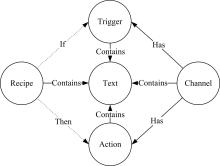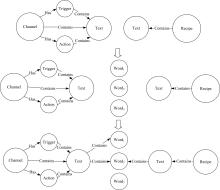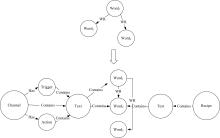吉林大学学报(工学版) ›› 2021, Vol. 51 ›› Issue (6): 2182-2189.doi: 10.13229/j.cnki.jdxbgxb20210848
• 计算机科学与技术 • 上一篇
基于文本融合的物联网触发动作编程模式服务推荐方法
- 吉林大学 计算机科学与技术学院,长春 130012
Text fusion based internet of things service recommendation for trigger⁃action programming pattern
Dong-ming SUN( ),Liang HU,Yong-heng XING,Feng WANG(
),Liang HU,Yong-heng XING,Feng WANG( )
)
- College of Computer Science and Technology,Jilin University,Changchun 130012,China
摘要:
针对一类物联网自动化驱动应用提出了一种服务推荐方法。该方法结合了文本分析、异构信息网络、深度学习技术,通过分析文本来寻找物联网中相关联的对象,进而达到推荐服务的目的。首先,构造异构信息网络,并将文本和文本关系融入其中,生成一种文本融合的异构信息网络;随后,设计元路径和关系权重;最终,训练生成神经网络模型用于对服务进行推荐。在一个真实的数据集上进行了实验评估,结果表明,本文方法可以对服务进行推荐,并明显优于一些经典方法。
中图分类号:
- TP391.1
| 1 | 丁琳,王会娟. 互联网技术进步对中国就业的影响及国别比较研究[J]. 经济科学, 2020(1): 72-85. |
| Ding Lin, Wang Hui-juan. The impact of internet technological change on employment in china and country comparison[J]. Economic Science, 2020(1): 72-85. | |
| 2 | 孙静愚. 数字地球技术及其应用研究[J]. 环球市场信息导报, 2017(8): 14-16. |
| Sun Jing-yu. Research on digital earth technology and its application[J]. Global Marhet Information Guide, 2017(8): 14-16. | |
| 3 | 郭志鹏, 李娟, 赵友刚, 等. 物联网中的无线传感器网络技术综述[J]. 计算机与应用化学, 2019, 36(1): 72-83. |
| Guo Zhi-peng, Li Juan, Zhao You-gang, et al. Review of wireless sensor networks technology in internet of things[J]. Computers and Applied Chemistry, 2019, 36(1): 72-83. | |
| 4 | 谢军, 庄建楼, 康成斌. 基于北斗系统的物联网技术与应用[J]. 南京航空航天大学学报, 2021, 53(3): 329-337. |
| Xie Jun, Zhuang Jian-lou, Kang Cheng-bin. Internet of things technology and application based on beidou system[J]. Journal of Nanjing University of Aeronautics & Astronautics, 2021, 53(3): 329-337. | |
| 5 | Teillet P M. Sensor webs: a geostrategic technology for integrated earth sensing[J]. IEEE Journal of Selected Topics in Applied Earth Observations & Remote Sensing, 2010, 3(4): 473-480. |
| 6 | 傅文博, 张杰, 陈永乐. 物联网环境下抵抗路由欺骗攻击的网络拓扑发现算法[J]. 吉林大学学报: 工学版, 2018, 48(4): 1231-1236. |
| Fu Wen-bo, Zhang Jie, Chen Yong-le. Network topology discovery algorithm against routing spoofing attack in internet of things[J]. Journal of Jilin University(Engineering and Technology Edition), 2018, 48(4): 1231-1236. | |
| 7 | Samie F, Bauer L, Henkel J. IoT Technologies for embedded computing: a survey[C]∥International Conference on Hardware/Software Codesign and System Synthesis, Pittsburgh, PA, USA, 2016:1-10. |
| 8 | 陈红松, 陈京九. 基于统计的物联网分布式拒绝服务攻击检测[J]. 吉林大学学报: 工学版, 2020, 50(5): 1894-1904. |
| Chen Hong-song, Chen Jing-jiu. Statistical based distributed denial of service attack detection research in internet of things[J]. Journal of Jilin University(Engineering and Technology Edition), 2020, 50(5): 1894-1904. | |
| 9 | Nguyen K T, Laurent M, Oualha N. Survey on secure communication protocols for the internet of things[J]. Ad Hoc Networks, 2015, 32: 17-31. |
| 10 | Wang F, Hu L, Zhou J, et al. A survey from the perspective of evolutionary process in the internet of things[J]. International Journal of Distributed Sensor Networks, 2015, 11(3): 1944-1947. |
| 11 | Teillet P M. Sensor webs: a geostrategic technology for integrated earth sensing[J]. IEEE Journal of Selected Topics in Applied Earth Observations & Remote Sensing, 2010, 3(4): 473-480. |
| 12 | Jian Z, Shan L H, Hu H L, et al. Mobile cellular networks and wireless sensor networks: toward convergence[J]. IEEE Communications Magazine, 2012, 50(3): 164-169. |
| 13 | Neuhaus H, Compton M. The semantic sensor network ontology[C]∥AGILE workshop on challenges in geospatial data harmonisation, Hannover, Germany, 2009: 1-33. |
| 14 | Gyrard A, Patel P, Datta S K, et al. Semantic web meets internet of things and web of things[C]∥Proceedings of the 26th International Conference on World Wide Web Companion, Kobe, Japan, 2017: 917-920. |
| 15 | Ling W, Blunsom P, Grefenstette E, et al. Latent predictor networks for code generation[C]∥Proceedings of the 54th Annual Meeting of the Association for Computational Linguistics, Berlin, Germany, 2016:599-609. |
| 16 | Quirk C, Mooney R, Galley M. Language to Code: learning semantic parsers for if-this-then-that recipes[C]∥Proceedings of the 53rd Annual Meeting of the Association for Computational Linguistics (ACL- |
| 17 | , Beijing, China, 2015: 878-888. |
| 18 | Compton M, Barnaghi P, Bermudez L, et al. The SSN ontology of the W3C semantic sensor network incubator group[J]. Journal of Web Semantics, 2012, 17: 25-32. |
| 19 | Ganzha M, Paprzycki M, Pawlowski W, et al. Semantic interoperability in the internet of things; an overview from the INTER-IoT perspective[J]. Journal of Network & Computer Applications, 2016, 81: 111-124. |
| 20 | Lin J W, Chelliah P R, Hsu M C, et al. Efficient fault-tolerant routing in iot wireless sensor networks based on bipartite-flow graph modeling[J]. IEEE Access, 2019, 7: 14022-14034. |
| 21 | Alasmary H, Khormali A, Anwar A, et al. Analyzing and detecting emerging internet of things malware: a graph-based approach[J]. IEEE Internet of Things Journal, 2019, 6(5): 8977-8988. |
| 22 | Hou Shi-fu, Ye Yan-fang, Song Yang-qiu, et al. HinDroid: an intelligent android malware detection system based on structured heterogeneous information network[C]∥The 23rd ACM SIGKDD International Conference, Halifax, Canada, 2017: 1507-1515. |
| 23 | Yao L N, Quan Z S, Ngu A, et al. Things of interest recommendation by leveraging heterogeneous relations in the internet of things[J]. Acm Transactions on Internet Technology, 2016, 16(2): 1-25. |
| 24 | ConceptNet[EB/OL]. [2021-02-20]. |
| 25 | Sun Y Z, Han J W, Yan X F, et al. PathSim: meta path-based top-k similarity search in heterogeneous information networks[J]. Proceedings of the VLDB Endowment, 2011, 4(11): 992-1003. |
| 26 | Mi X H, Qian F, Zhang Y, et al. An empirical characterization of IFTTT: ecosystem, usage, and performance[C]∥Proceedings of the 2017 Internet Measurement Conference, London, United Kingdom, 2017:398-404. |
| 27 | IFTTT[EB/OL]. [2021-02-22]. |
| [1] | 赵宏伟,霍东升,王洁,李晓宁. 基于显著性检测的害虫图像分类[J]. 吉林大学学报(工学版), 2021, 51(6): 2174-2181. |
| [2] | 王生生,陈境宇,卢奕南. 基于联邦学习和区块链的新冠肺炎胸部CT图像分割[J]. 吉林大学学报(工学版), 2021, 51(6): 2164-2173. |
| [3] | 林俊聪,雷钧,陈萌,郭诗辉,高星,廖明宏. 基于电影视觉特性的动态多目标实时相机规划[J]. 吉林大学学报(工学版), 2021, 51(6): 2154-2163. |
| [4] | 姚引娣,贺军瑾,李杨莉,谢荡远,李英. 自构建改进型鲸鱼优化BP神经网络的ET0模拟计算[J]. 吉林大学学报(工学版), 2021, 51(5): 1798-1807. |
| [5] | 赵宏伟,张子健,李蛟,张媛,胡黄水,臧雪柏. 基于查询树的双向分段防碰撞算法[J]. 吉林大学学报(工学版), 2021, 51(5): 1830-1837. |
| [6] | 张萌谡,刘春天,李希今,黄永平. 基于K⁃means聚类算法的绩效考核模糊综合评价系统设计[J]. 吉林大学学报(工学版), 2021, 51(5): 1851-1856. |
| [7] | 曹洁,屈雪,李晓旭. 基于滑动特征向量的小样本图像分类方法[J]. 吉林大学学报(工学版), 2021, 51(5): 1785-1791. |
| [8] | 孙小雪,钟辉,陈海鹏. 基于决策树分类技术的学生考试成绩统计分析系统[J]. 吉林大学学报(工学版), 2021, 51(5): 1866-1872. |
| [9] | 王春波,底晓强. 基于标签分类的云数据完整性验证审计方案[J]. 吉林大学学报(工学版), 2021, 51(4): 1364-1369. |
| [10] | 欧阳丹彤,刘扬,刘杰. 故障响应指导下基于测试集的故障诊断方法[J]. 吉林大学学报(工学版), 2021, 51(3): 1017-1025. |
| [11] | 钱榕,张茹,张克君,金鑫,葛诗靓,江晟. 融合全局和局部特征的胶囊图神经网络[J]. 吉林大学学报(工学版), 2021, 51(3): 1048-1054. |
| [12] | 朱小龙,谢忠. 基于机器学习的地理空间数据抽取算法[J]. 吉林大学学报(工学版), 2021, 51(3): 1011-1016. |
| [13] | 孙宝凤,任欣欣,郑再思,李国一. 考虑工人负荷的多目标流水车间优化调度[J]. 吉林大学学报(工学版), 2021, 51(3): 900-909. |
| [14] | 王淑敏,陈伟. 基于连续密度隐马尔可夫模型的矿下异常行为识别算法[J]. 吉林大学学报(工学版), 2021, 51(3): 1067-1072. |
| [15] | 刘元宁,吴迪,朱晓冬,张齐贤,李双双,郭书君,王超. 基于YOLOv3改进的用户界面组件检测算法[J]. 吉林大学学报(工学版), 2021, 51(3): 1026-1033. |
|
||







